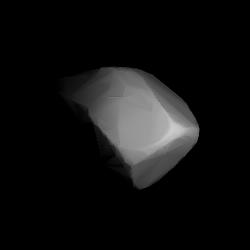 Shape model of Euler from its lightcurve | |
| Discovery[1] | |
|---|---|
| Discovered by | T. Smirnova |
| Discovery site | Crimean Astrophysical Obs. |
| Discovery date | 29 August 1973 |
| Designations | |
| (2002) Euler | |
| Pronunciation | /ˈɔɪlər/[2] |
Named after | Leonhard Euler (Swiss mathematician)[3] |
| 1973 QQ1 · 1938 DW 1942 GJ · 1953 EB 1973 SJ2 | |
| main-belt · (inner) | |
| Adjectives | Eulerian /juːˈlɪəriən/[4] |
| Orbital characteristics[1] | |
| Epoch 4 September 2017 (JD 2458000.5) | |
| Uncertainty parameter 0 | |
| Observation arc | 75.04 yr (27,408 days) |
| Aphelion | 2.5844 AU |
| Perihelion | 2.2512 AU |
| 2.4178 AU | |
| Eccentricity | 0.0689 |
| 3.76 yr (1,373 days) | |
| 0.3273° | |
| 0° 15m 43.92s / day | |
| Inclination | 8.5015° |
| 178.65° | |
| 53.294° | |
| Physical characteristics | |
| 17.4 km[5] 18.838±0.066[6] | |
| Mass | 5.5×1015 kg[citation needed] |
| 5.9929 h[7][8] | |
| 0.036±0.003[6] 0.0839±0.015[5] | |
| S[7] | |
| 12.4[1] · 12.7[7] | |
2002 Euler is a stony background asteroid from the inner regions of the asteroid belt, approximately 17 kilometers (11 miles) in diameter. It was discovered on 29 August 1973, by Russian astronomer Tamara Smirnova at the Crimean Astrophysical Observatory in Nauchnyj, and assigned the prov. designation 1973 QQ1. It was named after Swiss mathematician Leonhard Euler.[3][9]
- ^ a b c Cite error: The named reference
jpldatawas invoked but never defined (see the help page). - ^ "Euler". Oxford English Dictionary (Online ed.). Oxford University Press. (Subscription or participating institution membership required.)
- ^ a b Cite error: The named reference
springerwas invoked but never defined (see the help page). - ^ "Eulerian". Oxford English Dictionary (Online ed.). Oxford University Press. (Subscription or participating institution membership required.)
- ^ a b Cite error: The named reference
SIMPSwas invoked but never defined (see the help page). - ^ a b Cite error: The named reference
Masiero-2011was invoked but never defined (see the help page). - ^ a b c Cite error: The named reference
lcdbwas invoked but never defined (see the help page). - ^ Cite error: The named reference
geneva-obswas invoked but never defined (see the help page). - ^ Cite error: The named reference
MPC-Eulerwas invoked but never defined (see the help page).